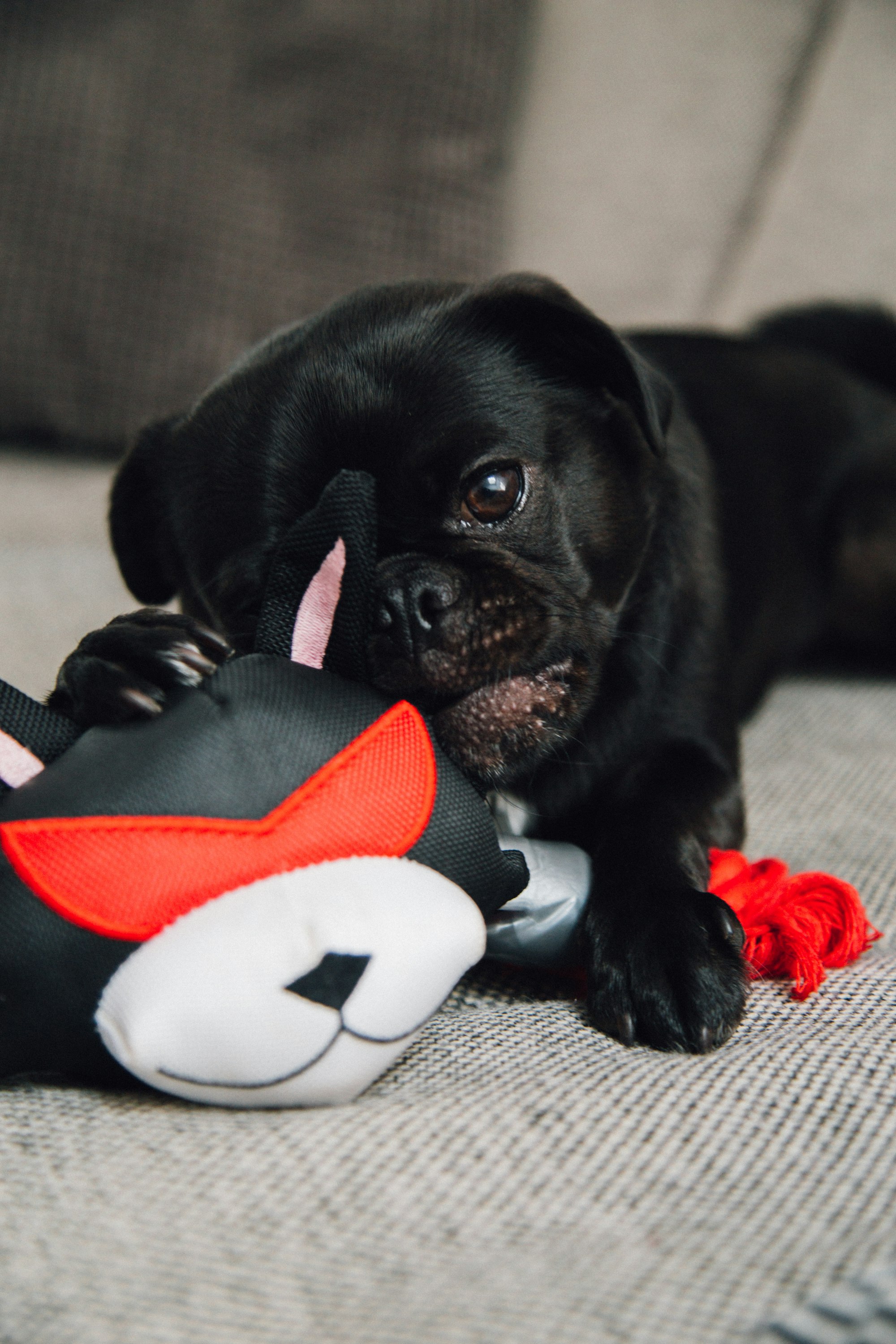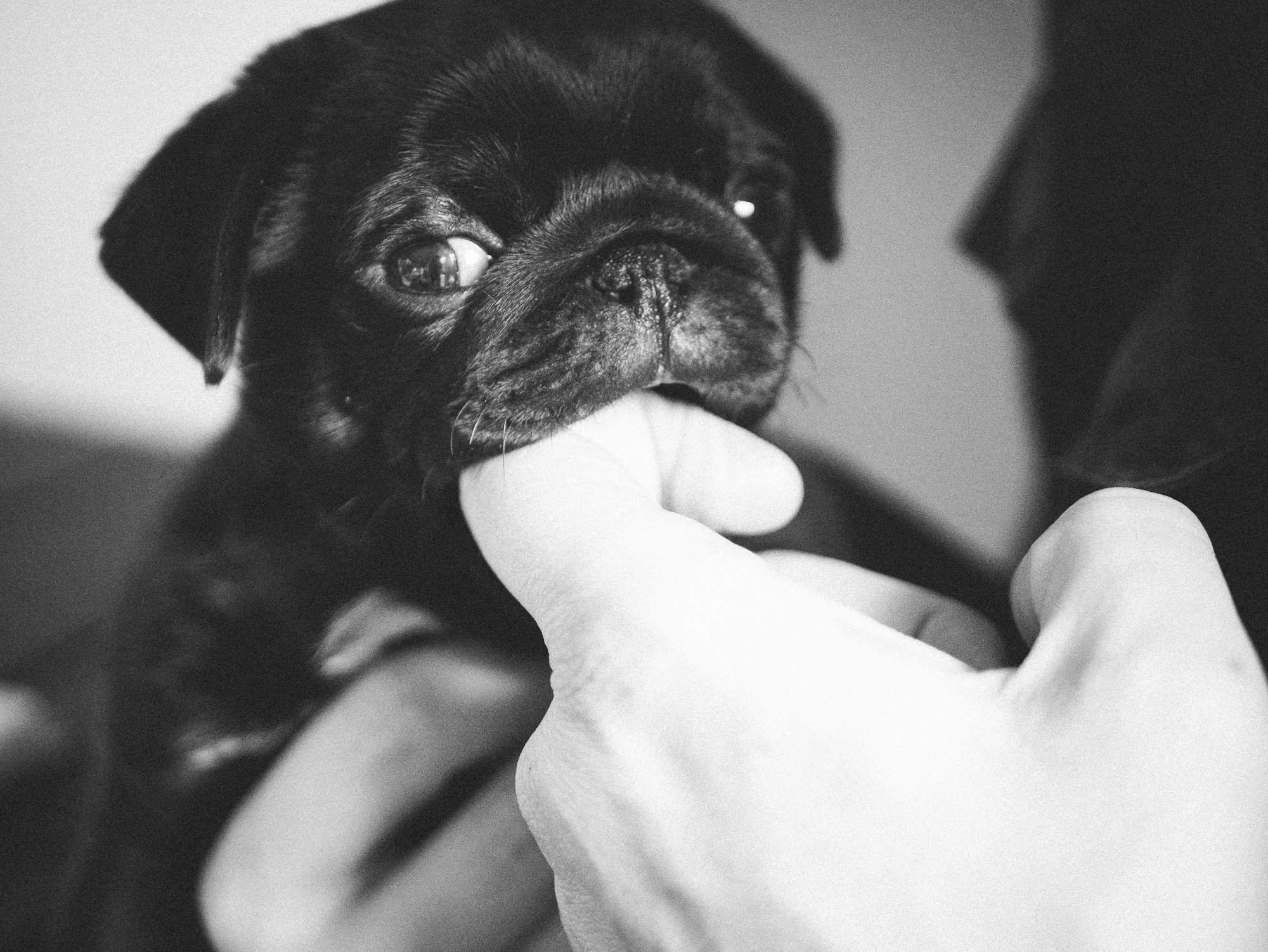Welcoming a Pug puppy into your home brings forth a bundle of affection, playfulness, and unique character. Pugs are beloved for their expressive faces and endearing personalities. In this detailed guide, we'll provide you with essential insights on how to care for and raise your Pug puppy, ensuring they grows into a happy and healthy member of your family.

Understanding the Pug Breed
Historical Origins
Pugs have a rich history dating back to ancient China, where they were cherished companions of royalty. Their distinctive appearance, colors and charming personality have made them popular worldwide.
Distinctive Physical Traits
Pugs are easily recognizable by their wrinkled faces, short snouts, and large, expressive eyes. Their compact size and sturdy build make them ideal for apartment living or any size of home.
Temperament and Charm
Pugs are known for their friendly and affectionate nature. They thrive on human companionship and are known to be social and adaptable, making them wonderful family pets.
Preparing Your Home for a Pug Puppy
Puppy-Proofing Essentials
Pug puppies are curious and playful, so puppy-proofing your home is essential to their safety. Remove small objects that could be swallowed, secure electrical cords, and create a safe space for them to explore.
Necessary Supplies
Gather important supplies before your Pug puppy arrives, including a comfortable bed, leash and harness, food and water bowls, high-quality puppy food, grooming tools, and interactive dog toys.
Creating a Cozy Corner
Designate a cozy and quiet area where your Pug puppy can rest and sleep. Provide soft bedding and ensure the space is away from drafts and excessive noise.
Diet and Nutrition:
Providing your Weimaraner puppy with a balanced and nutritious diet is essential for their growth, energy levels, and overall well-being. Here are some guidelines to follow:
- Puppy Food: Choose a high-quality commercial puppy food that is specifically formulated for large breeds. Look for options that list meat as the primary ingredient and avoid foods with excessive fillers or artificial additives.
- Portion Control: Follow the feeding guidelines on the dog food packaging, but also monitor your puppy's body condition. Adjust the portions based on their age, activity level, and growth rate to prevent overfeeding or underfeeding.
- Meal Schedule: Establish a consistent feeding schedule, typically three times a day for young puppies. As your puppy grows, you can transition to two meals a day.
- Fresh Water: Always provide fresh, clean water for your puppy. Proper hydration is crucial for their health and digestion.
- Treats: Use treats for training and rewards, but do so in moderation. Choose healthy, puppy-friendly treats and factor them into your puppy's overall daily caloric intake.
- Avoid Human Foods: Some human foods can be toxic to dogs, including chocolate, grapes, onions, and garlic. Stick to dog-safe treats and avoid sharing your meals with your puppy.
- Consult Your Vet: Consult your veterinarian for guidance on your puppy's specific nutritional needs. They can recommend the best food and feeding routine based on your puppy's individual requirements.
Training and Socialization:
Training and socialization are crucial aspects of raising a well-behaved and confident Weimaraner puppy:
- Obedience Training: Start training your Weimaraner puppy with basic commands like "sit," "stay," "come," and "down." Positive reinforcement, such as treats and praise, works well to motivate these eager-to-please dogs.
- Puppy Classes: Enroll your puppy in a reputable puppy training class. These classes provide structured training and socialization opportunities in a controlled environment.
- Socialization: Expose your puppy to a variety of people, places, animals, and situations during their critical socialization period (up to 16 weeks). This helps prevent fear and aggression later in life.
- Leash Training: Teach your puppy to walk on a leash without pulling. A well-mannered dog on walks enhances both safety and enjoyment.
- Crate Training: Crate training can help with housebreaking and provide your puppy with a safe, comfortable space. Ensure the crate is associated with positive experiences.
- Consistency: Consistency is key in training. Use the same commands and rewards every time, and ensure everyone in the household is on the same page.
- Positive Reinforcement: Reward good behavior with treats, praise, and affection. Avoid punishment-based training methods, as they can lead to fear and separation anxiety.
- Patience: Training takes time, especially with puppies. Be patient, and celebrate small victories along the way.
- Continued Learning: Training doesn't stop once your puppy grows up. Continue practicing commands and reinforcing good behavior throughout their life.
Remember that training and socialization go hand in hand, contributing to a well-rounded and well-adjusted Weimaraner that is a joy to have as part of your family.

Exercise and Playtime
Pugs are lively and playful companions that benefit from regular exercise and engaging playtime. Providing them with physical and mental stimulation helps keep them happy and healthy. Here's how to ensure your Pug puppy gets the right amount of exercise and play:
- Daily Walks: Take your Pug puppy for daily walks to provide them with fresh air and mental stimulation. Aim for at least 20 to 30 minutes of walking each day.
- Interactive Play: Engage in interactive play sessions with toys like squeaky toys, balls, and puzzle toys. These activities satisfy their curious minds and playful nature.
- Hide-and-Seek: Hide treats or toys around the house for your Pug to find. This game taps into their scent-driven instincts and keeps them entertained.
- Social Play: Arrange playdates with other friendly dogs or introduce your Pug to dog parks where they can interact and play with other pups.
- Training Games: Incorporate training into playtime by teaching your Pug simple commands like "sit," "stay," and "come." This mental stimulation adds an educational element to their play.
Grooming and Coat Care
Pugs have a short, smooth coat that requires routine care to keep them looking and feeling their best. Regular grooming not only enhances their appearance but also promotes their overall well-being. Here's how to care for your Pug's coat:
- Brushing: Brush your Pug's coat once or twice a week to remove loose hair and distribute natural oils. This helps minimize pug shedding and keeps their coat glossy.
- Bathing: Pugs have sensitive skin, so bathe them only when necessary or when they get dirty. Use a gentle, dog-specific shampoo to prevent skin irritation.
- Wrinkle Care: Pugs have adorable facial wrinkles that require special attention. Gently clean the wrinkles using a damp cloth or hypoallergenic baby wipes. Dry the wrinkles thoroughly to prevent skin issues.
- Ear Cleaning: Check your Pug's ears regularly for dirt or wax buildup. Clean the ears using a dog-specific ear cleaner and a cotton ball, being careful not to insert anything deep into the ear canal.
- Nail Trimming: Trim your Pug's nails regularly to prevent overgrowth. Be cautious not to cut too close to the quick, which can cause bleeding and discomfort.
- Dental Hygiene: Pugs are prone to dental issues, so brush their teeth regularly using a dog-specific toothbrush and toothpaste. Dental chews and toys can also help maintain oral health.
Healthcare and Vet Visits
Proper healthcare is crucial for keeping your Pug puppy healthy and ensuring a long, happy life. Regular visits to the veterinarian and preventive care are essential components of responsible pet ownership. Here's how to provide optimal healthcare for your Pug puppy:
- Vaccination Schedule: Follow your veterinarian's recommended vaccination schedule to protect your Pug from common diseases. Vaccinations typically start at 6-8 weeks of age and continue at specific intervals.
- Parasite Control: Keep your Pug protected from fleas, ticks, and internal parasites like worms. Use veterinarian-recommended preventive medications and consult your vet for proper administration.
- Regular Check-ups: Schedule regular wellness check-ups with your veterinarian. These visits allow for early detection of health issues and ensure your Pug's overall well-being.
- Dental Care: Pugs are prone to dental problems, so prioritize their oral health. Brush your Pug's teeth regularly and consider dental treats or toys that promote good dental hygiene.
- Spaying/Neutering: Discuss spaying or neutering with your veterinarian. This procedure not only prevents unwanted litter but also offers health benefits for your Pug.

Building a Strong Bond
Developing a strong bond with your Pug puppy is an enriching experience. A strong bond enhances communication, trust, and companionship. Here's how to build a deep connection with your furry friend:
- Quality Time: Spend quality time with your Pug through play, training, and relaxation. Engaging in activities they enjoy fosters a sense of belonging.
- Positive Reinforcement: Use positive reinforcement techniques during training to create a positive association with learning. Reward good behavior with treats, praise, and affection.
- Physical Touch: Pugs are affectionate dogs that enjoy physical touch. Regularly petting, cuddling, and gentle massages help strengthen the bond between you and your Pug.
- Training Together: Participate in training sessions to establish clear communication. Consistent training builds mutual understanding and reinforces your role as a leader.
- Outdoor Adventures: Take your Pug on outdoor adventures like walks, hikes, and visits to dog-friendly parks. Exploring together creates shared memories and experiences.
- Respect Boundaries: Respect your Pug's boundaries and signals. Understand their preferences and create a safe environment where they feel comfortable.
By prioritizing your Pug's healthcare needs and building a strong bond through positive interactions and shared experiences, you're ensuring a fulfilling and joyful relationship with your four-legged companion.
The Joy of Pug Ownership
Owning a Pug brings immeasurable joy and an array of heartwarming experiences. Pugs are known for their affectionate nature, playful antics, and unwavering loyalty. Here's why welcoming a Pug into your life is a source of immense happiness:

- Unconditional Love: Pugs are renowned for their loving and loyal personalities. They form deep bonds with their owners and thrive on companionship, offering unwavering love and devotion.
- Endearing Behavior: Pugs have a knack for making people smile with their comical and charming behavior. Their playful antics and expressive faces never fail to brighten your day.
- Cuddly Companionship: Pugs are natural cuddlers that love nothing more than snuggling up beside you. Their affectionate nature provides comfort and companionship during quiet moments.
- Joyful Playtime: Watching your Pug play and frolic is a source of pure delight. Their energy and enthusiasm are infectious, making playtime a truly joyful experience.
- Entertainment Factor: Pugs are natural entertainers, often indulging in hilarious behaviors that leave you in stitches. From zooming around the room to tilting their heads in curiosity, they're a constant source of amusement.
- Loyal Friends: Pugs are fiercely loyal and protective of their families. Their presence provides a sense of security, and they're always ready to stand by your side.
- Shared Adventures: Whether it's a leisurely stroll through the park, a day at the beach, or a cozy movie night at home, every moment with your Pug becomes a cherished memory.
- Bonding Opportunities: Owning a Pug fosters a unique bond that grows stronger over time. Through training, play, and everyday interactions, you build a connection that transcends words.
- Positive Impact: Pugs have an innate ability to brighten your mood and reduce stress. Their joyful spirit and unconditional love have a positive impact on your overall well-being.
The joy of Pug ownership goes beyond words, as these charming and lovable companions enrich every facet of your life. From the heartwarming moments to the shared adventures, owning a Pug is a privilege that brings immeasurable happiness and love.
Conclusion
Caring for a Pug puppy requires patience, love, and understanding. By preparing your home, providing proper nutrition, and building a strong bond, you'll embark on a delightful journey with your charming Pug companion.
FAQs
Q1: Are Pugs good with children?
A: Yes, Pugs are generally good with children due to their gentle nature. However, always supervise interactions to ensure both the child and Pug are comfortable.
Q2: How much exercise do Pug puppies need?
A: Pug puppies require short bursts of play and exercise. As they grow, engage in gentle walks and play sessions to prevent obesity.
Q3: Do Pugs have specific grooming needs?
A: Pugs have a short coat that requires regular brushing to minimize shedding. Pay special attention to their facial folds to prevent moisture buildup.
Q4: Are Pugs prone to health issues?
A: Pugs can be prone to respiratory issues due to their flat faces. Regular vet visits and proper care can help manage potential health concerns.
Q5: Can Pugs be left alone for long periods?
A: Pugs are social dogs that enjoy companionship. While they can tolerate short periods alone, they thrive when part of the family's daily activities.